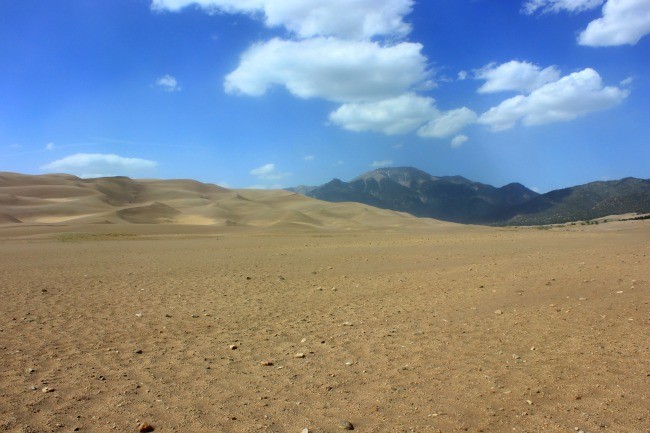For those who love the desert landscape, the state of Colorado is not a destination that comes to mind – shouldn’t a traveller be heading to the Middle East or North Africa?
In southern Colorado, Great Sand Dunes National Park and Preserve offers a unique experience thanks to the annual habits of Mother Nature to bring together seasonal changes and environment in the creation of this park’s crowning glory – the highest sand dunes in North America.
Put aside the typical mountainous areas one assumes of Colorado. Picture flat grasslands, similar to the Midwest, and a palate of cream, yellow and brown – the endless green forest is a distant memory.
We make the turn off to the national park, heading down another dusty road, curiosity now peaked as we get closer to this natural wonder. Thanks to a steady wind, the dust swirls across the landscape, hiding the distant dunes from sight. All we can see from the van windows are dry grasses and clumps of bushes.
In the western United States, this landscape rarity draws a steady stream of visitors from neighbouring states, curious to see this phenomenon, which is maintained every year with the change of seasons creating the right environment for the dunes.
Another sign appears, indicating the welcome center for the national park and we’re offered a first glimpse of the massive dunes as the winds allow us a peek – cream coloured piles of sand without any vegetation, located below a bright blue sky.
After a quick orientation, we head down to the park entrance, crossing the wide, now shallow Medano Creek to head towards the sand dunes, across a windswept flat ground. We can’t go any further with the vehicle, and I wish we had a dune buggy to quickly traverse the land ahead of us, my desire to get up close and personal increasing.
The wind is strong, and I have to stop several times as the strong gusts pelt my skin with the sandy particles, keeping my eyes and mouth closed until the wind calms so I can continue. This trek has turned into a slow battle, as the wind showers me with sand, but I’m not discouraged, I keep walking. My group has split up – everyone at their own pace – but everyone steadily continues towards the dunes.
It’s taking longer than I initially assumed, and despite the steady wind I push on, committed to getting to the first dune. As I finally climb up the beginning of one sand dune, the softness I expected is not there – my feet aren’t sinking and the ground feels firm as I traverse upwards.
I stop to stand on one of the lower sand dunes, taking photos of my surroundings when the wind gusts subside. I gaze across the landscape, seeing my footprints slowly disappearing and marvel at the size of these dunes, easily the height of small highrises. I see other visitors, mainly kids, roll down the dunes on their sides, laughing as they reach the bottom of the lower dunes and scramble back up to do it again.
I can taste the sand in my mouth, while my arms and legs feel like they’ve been scrubbed with a hairbrush. As I walk back, I shield my face and camera, once again stopping when the sand-laden wind overwhelms me. After I’ve left I can’t look back at where I was, as the dust once again obscures my view of the sand dunes.
The next day, I see the dunes while horseback riding on the acreage of Zapata Ranch. Their stillness attracts my gaze as I ride across the ranchlands, still surprised by their size and elegance. I wish I could return and try to climb up the dunes again, to see how far I could explore this uncommon landscape of Colorado.


